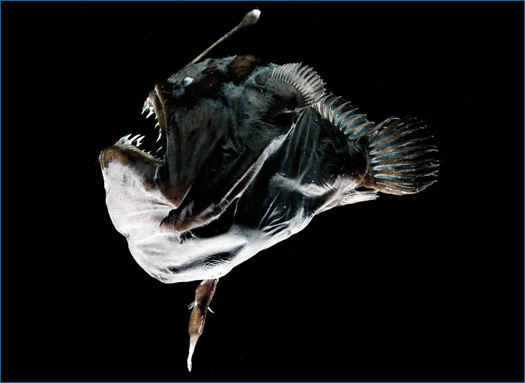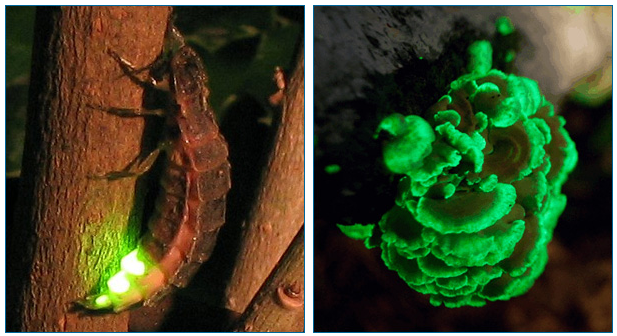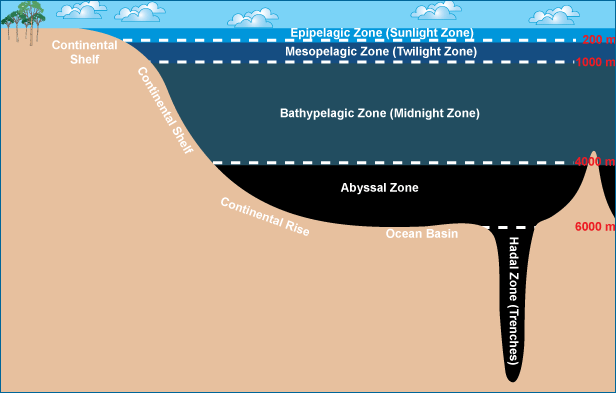Imagine descending into the ocean’s depths in a submarine. At first, you are in a bright underwater world, full of fish, marine mammals, plankton, and coral reefs. This is called the epipelagic zone. As you move deeper into this alien universe and approach the depth of 200 meters, your surroundings become dark rapidly, and you can barely make out the shapes of organisms. You are now in the mesopelagic zone, the twilight zone. Below 1000 meters (bathypelagic zone), the underwater world outside your submarine window becomes completely dark. To reach the bottom of the ocean, however, you would still have to descend about four times as deep as you are now! Moving deeper into the blackness, you see a tiny light in the inky depths (abyssopelagic zone). What illuminates the ocean where sunlight can’t penetrate? An animal that makes its own light — the anglerfish, a member of the clade Lophiiformes (LAH-fee-uh-FOR-meez)!
The anglerfish’s light emanates from the end of fishing-rod-like extension on its forehead. It uses this surprising adaptation to lure prey out of the dark and close enough for its razor-toothed jaws to strike. The angling structure evolved from the spines of the fish’s dorsal fin. The end of this structure is inhabited by large numbers of bioluminescent bacteria, which provide the anglerfish with its glow.

You might think such an extreme adaptation would be a rarity, but in fact many species have the ability to bioluminesce. Other predatory deep-sea fish use bioluminescent light to confuse prey, to see their prey, to startle predators, to attract mates, and more. Lots of non-fish species use bioluminescence as well — some bacteria, sponges, jellyfish, crustaceans, segmented worms, squids, sharks, and even plenty of terrestrial species like fireflies. All bioluminescence is caused by a chemical reaction. Some of these organisms produce the necessary chemicals themselves, while others, like the anglerfish, rely on the help of symbiotic bacteria.

Given the diversity of bioluminescent organisms and the different ways in which they produce their light, it should come as no surprise that this ability has evolved many times. The ray-finned fish lineages in which bioluminescence has evolved are highlighted on this phylogeny.
Haddock, S. H. D., Moline, M. A., and Case, J. F. Bioluminescence in the sea. Annual Review of Marine Science 2:443-93.
Helfman, G. S., Collette, B. B., and Facey, D. E. 1997. The Diversity of Fishes. 535 pp. Blackwell Publishing, Malden, MA.
Wiley, E. O. and Johnson, G. D. 2010. A teleost classification based on monophyletic groups. In J. S. Nelson, H.-P. Schultze, & M. V. H. Wilson (eds) Origin and Phylogenetic Interrelationships of Teleosts. Pp. 123-182, Verlag Dr. Friedrich Pfeil, München, Germany.
Davis, M. P., Holcroft, N. I., Wiley, E. O., Sparks, J. S., and Smith, W. L. 2014. Species-specific bioluminescence facilitates speciation in the deep sea. Marine Biology (italicize that). DOI 10.1007/s00227-014-2406-x.


